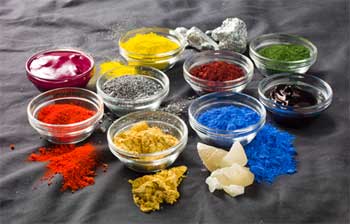How to Produce Emulsion Paint
In my previous post, I discussed different chemicals used in making paints and the different types of water-based and oil-based paints. You can make any type of paints, whether gloss or emulsion, satin (nylon) paint, textcoat, name it, with our guide on paint production.
In this post, I will give you some few information on making gloss paint.
Mixing of Calcium Carbonate in water
Step 1:For one bucket production i.e. normal 20 liters of paint container, pour water in the bucket up to about [
NOTE: If you are producing white paint, you will mix titanium dioxide in water before adding calcium. 2 spoons of titanium dioxide are enough. Ensure you mix very well.
Step 2:
Coloration: It is assumed that by now you must have diluted the colours as required with water if they are in oxide or in powder form. Now put colour in small quantity and keep turning until you get your desired result. You can always add more if you like. Suppose you added more yellow for example than you need, you can correct it by adding more calcium (but not after this stage). Bear in mind that the colour may be deeper when wet and lighter when the paint is dried.
Step 3:
Add - kg [
Final step
When you have completed the above steps, make sure that you turn the above mixture very well. As you are turning it you might be a little fidgeted that you have wasted your resources. You don’t need to be afraid. Just add acrytext to the mixture and turn. Add it in small quantity until you get the thickness you desire. However, if you add access you might spoil your mixture.
For Large Quantity Production
If we are working with 350 liters of a bucket, we shall have about 16 drums of paint after production. Now 350 liters bucket goes with -liters of water [Add [
1kg of titanium dioxide (if you a producing white paint)
- kg [
1 kg of Nitrosol
Others chemicals have no specific quantity. You just add with discretion but make sure you do not over add especially Acrytext.
How to Produce Textcoat (1 drum Production)
Step 1:Pour about 6 liters of water into the bucket, add - bag [
Step 2:
Now after turning the mixture above, you add marble dust. There are two types of marble dust, the smooth and the rough ones. The type you use depends on what you want to achieve.
You will notice that some textcoat paints have a kind of lining and some have a rough surface. And there are those that are called designer textcoat such are the ones that they use with the aid of a special roller to design houses so that its end effect will be something like flowers or blocks made of paint.
I’m sure you must have seen such paint. It is called artwork in the painting industry. All these are textcoat but it is the mode of application of marble dust that makes different types.
For rough textcoats use only rough marble dust in your production. For lining textcoats use a combination of rough and smooth marble dust in an equal ratio( if you are producing this one I will advise you add smooth marble dust first after stirring add the rough one)
For artwork textcoats use only smooth marble dust in production. Now as you are adding the marble dust, you will notice that the volume of your mixture is increasing. Just add according to your own discretion, it has no specific measurement. If you are confused on the quantity to add, just keep adding until the container of the dust is ¼ empty. Use your initiative. (for 1 drum marble dust will only be about half of big custard bucket) if you are combining the dust, the rough + smooth will give you the half of the custard bucket).
Please do not use only smooth marble dust for production unless you are producing artwork that needs a designer roller.
Step 3:
When you are through with stirring of this mixture, ensure you stir it very well, you will now add your P.V.A. and other chemicals like we said in the production of emulsion above. However you will need to increase their volume a little. For example, you will need a full glass cup of Natrosol and increase the volume of other chemicals a little.
For the production of textcoat put - centiliters [
Now to know if the Acrytext you added is enough, take a small portion of the paint and touch it on the wall. If the paint does not fall off congratulations! If it is falling add more acrytext and your paint is ready.
Bigger Quantity Production
- 350 liters bucket will give us 15 drums of textcoat paint
- Add - drums [
measurement in the manual]of water. - Use - bags [
measurement in the manual] of calcium - Use [
measurement in the manual] bag of marble dust i.e. - for rough, - for smooth - Empty - kg of Natrosol and - kg [
measurement in the manual] of P.V.A. - Put - centiliters [
measurement in the manual] of formalin and about the same volume for ammonia and hydrosol.
If you cannot turn the whole paint when you add acrytext, divide them out into smaller volumes in different buckets and add your acrytext so that you can turn it with ease.
To get detailed measurement of each of the above chemicals, you need to order the paint production manual. With the manual you can produce different types of paints you can ever imagine. You can produce different types of water based paints such as Emulsion Paint
- Textured Paint
- Flextured Paint
- Satin or Nylon Paint
- POP Paint
- Matt Eggshell
- Flex Coat Paint
- Textured Matt Paint
- Marble Trowel Paint
- Marble Effect Paint
- Base Coat Paint
- Graffitex Paint
And oil-based paint such as:
- Gloss paint
- Varnish
- Undercoat
- Anti-rust
You can get the details of the manual and how to place an order here: How to make different types of paints - Gloss and Emulsion.





















No comments